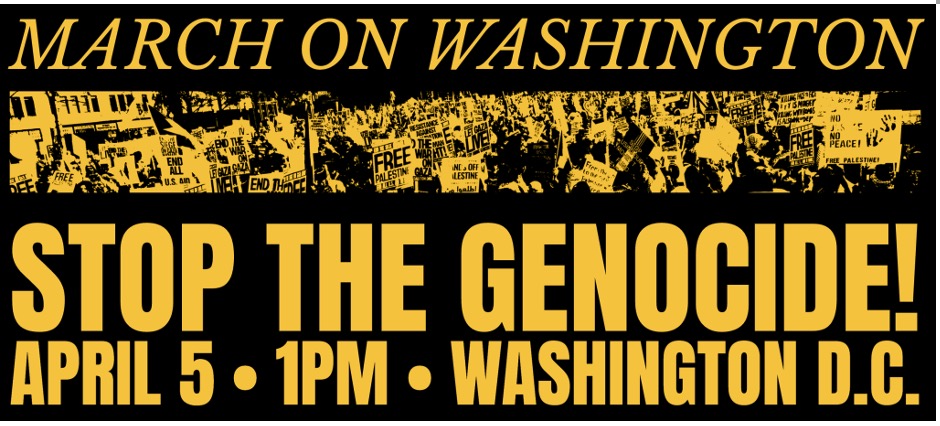Comments
VOICES OF THE PEOPLE - On Saturday, April 5, 2025, there were two major demonstrations in Washington, DC.
The demonstration widely covered by the mainstream media was part of the Hands Off/50501 actions held across the entire country. Except for an occasional picket sign that mentioned Gaza, the focus of these protests was strictly domestic issues, with no references to the US-supported Israeli genocide of Palestinians in Gaza and the US proxy war in Ukraine. For that matter, the organizers never mentioned the kidnapping of Mahmoud Khalil, a leader of the student encampment at Columbia University in 2024, or similar efforts to deport other students.

If the genocidal policies of the Biden and now Trump administrations in Gaza upset you, you were welcome at the other Washington, DC demonstration, the National March for Palestine. Its focus was US foreign policy, more specifically U.S government support for Israel’s genocidal 16 month attacks on mostly children, mothers, and elderly Palestinians in Gaza.
These are other differences, as well, between these two events. Unlike the National March to Stop the Genocide, the Hands Off/50501 demonstrations were extensively covered by the mainstream media. Furthermore, the organizers of the Hands Off demonstrations came from Indivisible, Political Revolution (created in 2016 to support Bernie’s presidential campaign), the Women’s March, and similar organizations appended to the Democratic Party. Their targets were Donald Trump, Elon Musk, and the firing of US government employees at non-Pentagon agencies.
To be clear, I think both demonstrations had political weaknesses. The 50501/Hands-Off demonstrations called themselves the resistance, but did not explain what resistors do, other than voting against Trump. More specifically, the Hands Off demonstrations did not distribute handouts or collect sign-up sheets, so those who showed up on April 5 would know what else they could do.
As for the National March for Palestine, Jewish Voice for Peace was there, but the vibe was Palestinian nationalism, with plenty of Palestinian flags, kaffiyehs, and chants for Palestine to be free. Unlike South Africa, where the African National Congress represented everyone, regardless of their racial or ethnic identity, the National March for Palestine only called for a ceasefire and arms embargo. While these are necessary, the march did not present a broader solution:
“The Trump administration, building on the tactics of the Biden administration, is now increasing its attempts to silence pro-Palestine, anti-genocide voices. . . That is why on April 5th we are standing up to Trump and his ethnic cleansing plan for Gaza, we are standing up to repression, and we are standing up to the US’s continued facilitation of the genocide in Gaza. We demand a permanent ceasefire and an arms embargo now!”
How do we explain the difference between these two marches? To their credit, the National March for Palestine was clear that US military and financial support for the Israeli government’s wars is totally bi-partisan. If we look further, there is no grass roots call in the US to murder Palestinians in Gaza. This is confirmed by a Pew Research Center survey from March 2025. It confirmed that US public opinion does not drive the Trump Administration’s military and diplomatic support for Israel’s relentless attacks on Gaza, as well as Lebanon and Syria.
A slight majority of Americans (53%) now express a somewhat or very unfavorable opinion of Israel. This marks an 11-point increase in unfavorable views since March 2022, when we last asked this question. The share of U.S. adults who voice very unfavorable views of Israel has roughly doubled over this period, from 10% in 2022 to 19% in 2025.
Assuming that both the Hands Off and pro-Palestinian demonstrations will continue, what can we expect? Several million people showed up on April 5. Most were formerly passive voters, yet they quickly figured out how to make picket signs and take over streets. Right below the surface of electoral civility, millions of people displayed hidden skills for non-electoral political activism.
It is hard to predict where this will lead, but US history offers several examples. In the 1930s there were successful sit-down strikes in factories, and in the late 1960s and early 1970s there was large-scale opposition to the Vietnam War within the US military.
Can Washington rely on the groups organizing future demonstrations to maintain a narrow focus on domestic issues – or calls for cease-fire -- if the US government militarily escalates in Gaza, Syria, Iran, Ukraine, and China. After all, the US is already providing vast quantities of weapons and intelligence to Israel. If Trump II continues to expand these wars, with broad support from Congressional Democrats, can these existing organizations prevent a Vietnam-style anti-war movement from quickly emerging?
At this point, this is the underlying political question, especially if living standards in the US precipitously decline.
(Victor Rothman is a California-based political analyst and a contributor to CityWatchLA.com.)






